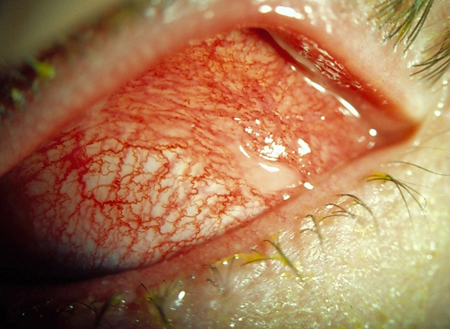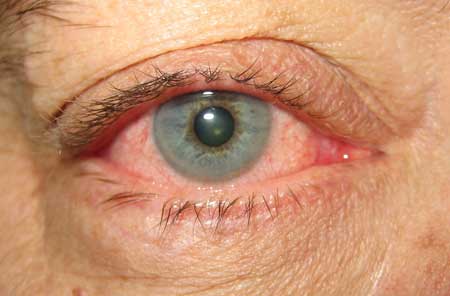Conjunctivitis commonly affects men, women and children of all ages. In the US, 3% of all emergency department visits are ocular related, with 30% of these due to conjunctivitis. Two percent of all visits to primary care physicians are for eye conditions, with 54% of these being either conjunctivitis or corneal abrasion.[2]Shields T, Sloan PD. A comparison of eye problems in primary care and ophthalmology practices. Fam Med. 1991 Sep-Oct;23(7):544-6.
http://www.ncbi.nlm.nih.gov/pubmed/1936738?tool=bestpractice.com
Similarly, in England, there are 13-14 cases in 1000 people per year.[3]Manners T. Managing eye conditions in general practice. BMJ. 1997 Sep 27;315(7111):816-7.
http://www.ncbi.nlm.nih.gov/pubmed/9345194?tool=bestpractice.com
[4]Royal College of General Practitioners, Royal College of Ophthalmologists. Ophthalmology for general practice trainees. London: Medical Protection Society; 2001. The incidence rate appears to be higher in children ages <1 year old (80 cases in 1000 patient-years) than in children ages >4 years (12 cases in 1000 patient-years).[5]Rietveld RP, ter Riet G, Bindels PJ, et al. Do general practitioners adhere to the guideline on infectious conjunctivitis? Results of the Second Dutch National Survey of General Practice. BMC Fam Pract. 2007 Sep 16;8:54.
https://bmcfampract.biomedcentral.com/articles/10.1186/1471-2296-8-54
http://www.ncbi.nlm.nih.gov/pubmed/17868475?tool=bestpractice.com
Seasonal conjunctivitis represents >90% of cases of allergic conjunctivitis.[6]Dart JK, Buckley RJ, Monnickendan M, et al. Perennial allergic conjunctivitis: definition, clinical characteristics and prevalence. A comparison with seasonal allergic conjunctivitis. Trans Ophthalmol Soc UK. 1986;105(Pt 5):513-20.
http://www.ncbi.nlm.nih.gov/pubmed/3467503?tool=bestpractice.com
[7]Ono SJ, Abelson MB. Allergic conjunctivitis: update on pathophysiology and prospects for future treatment. J Allergy Clin Immunol. 2005 Jan;115(1):118-22.
http://www.ncbi.nlm.nih.gov/pubmed/15637556?tool=bestpractice.com
[8]Buckley RJ. Allergic eye disease: a clinical challenge. Clin Exp Allergy. 1998 Dec;28 Suppl 6:39-43.
http://www.ncbi.nlm.nih.gov/pubmed/9988434?tool=bestpractice.com
[9]Bielory L. Differential diagnoses of conjunctivitis for clinical allergist-immunologists. Ann Allergy Asthma Immunol. 2007 Feb;98(2):105-14; quiz 114-7, 152.
http://www.ncbi.nlm.nih.gov/pubmed/17304876?tool=bestpractice.com
[10]Choi SH, Bielory L. Late-phase reaction in ocular allergy. Curr Opin Allergy Clin Immunol. 2008 Oct;8(5):438-44.
http://www.ncbi.nlm.nih.gov/pubmed/18769198?tool=bestpractice.com
An online survey in the US found that the majority of patients with seasonal conjunctivitis report moderate to severe symptoms that significantly impair their quality of life.[11]Meltzer EO, Farrar JR, Sennett C. Findings from an online survey assessing the burden and management of seasonal allergic rhinoconjunctivitis in US patients. J Allergy Clin Immunol Pract. 2017 May-Jun;5(3):779-89.e6.
https://www.sciencedirect.com/science/article/pii/S221321981630544X?via%3Dihub
http://www.ncbi.nlm.nih.gov/pubmed/27914815?tool=bestpractice.com
Perennial conjunctivitis is less common, but 80% of these patients have seasonal flares.[6]Dart JK, Buckley RJ, Monnickendan M, et al. Perennial allergic conjunctivitis: definition, clinical characteristics and prevalence. A comparison with seasonal allergic conjunctivitis. Trans Ophthalmol Soc UK. 1986;105(Pt 5):513-20.
http://www.ncbi.nlm.nih.gov/pubmed/3467503?tool=bestpractice.com
Atopic allergic conjunctivitis disease is more common in adults, and vernal allergic conjunctivitis (a more severe, chronic form of allergic conjunctivitis) is more common in boys.[12]Bruschi G, Ghiglioni DG, Cozzi L, et al. Vernal keratoconjunctivitis: a systematic review. Clin Rev Allergy Immunol. 2023 Aug;65(2):277-329.
https://pmc.ncbi.nlm.nih.gov/articles/PMC10567967
http://www.ncbi.nlm.nih.gov/pubmed/37658939?tool=bestpractice.com
Atopic and vernal conjunctivitis together represent 2% of ocular allergic disease; atopic dermatitis occurs in 3% of the population, and 25% of these have ocular involvement.[7]Ono SJ, Abelson MB. Allergic conjunctivitis: update on pathophysiology and prospects for future treatment. J Allergy Clin Immunol. 2005 Jan;115(1):118-22.
http://www.ncbi.nlm.nih.gov/pubmed/15637556?tool=bestpractice.com
[8]Buckley RJ. Allergic eye disease: a clinical challenge. Clin Exp Allergy. 1998 Dec;28 Suppl 6:39-43.
http://www.ncbi.nlm.nih.gov/pubmed/9988434?tool=bestpractice.com
[9]Bielory L. Differential diagnoses of conjunctivitis for clinical allergist-immunologists. Ann Allergy Asthma Immunol. 2007 Feb;98(2):105-14; quiz 114-7, 152.
http://www.ncbi.nlm.nih.gov/pubmed/17304876?tool=bestpractice.com
[10]Choi SH, Bielory L. Late-phase reaction in ocular allergy. Curr Opin Allergy Clin Immunol. 2008 Oct;8(5):438-44.
http://www.ncbi.nlm.nih.gov/pubmed/18769198?tool=bestpractice.com
Vernal keratoconjunctivitis is more common in males.[1]Cheung, Albert Y. et al. Conjunctivitis preferred practice pattern. Ophthalmology. 2024 Feb 12;131(4): 134-204.
https://www.aaojournal.org/article/S0161-6420(24)00009-5/fulltext
[13]Alemayehu AM, Yibekal BT, Fekadu SA. Prevalence of vernal keratoconjunctivitis and its associated factors among children in Gambella town, southwest Ethiopia, June 2018. PLoS One. 2019;14(4):e0215528.
https://pmc.ncbi.nlm.nih.gov/articles/PMC6472775
http://www.ncbi.nlm.nih.gov/pubmed/30998721?tool=bestpractice.com
Vernal keratoconjunctivitis prevalence varies widely geographically and has seasonal variation, greatest in hot, dry climates, highest incidence in African countries.[12]Bruschi G, Ghiglioni DG, Cozzi L, et al. Vernal keratoconjunctivitis: a systematic review. Clin Rev Allergy Immunol. 2023 Aug;65(2):277-329.
https://pmc.ncbi.nlm.nih.gov/articles/PMC10567967
http://www.ncbi.nlm.nih.gov/pubmed/37658939?tool=bestpractice.com
Prevalence estimates, based on limited evidence, indicate that bacterial conjunctivitis is more common in children, and viral conjunctivitis is more common in adults.[14]Johnson D, Liu D, Simel D. Does this patient with acute infectious conjunctivitis have a bacterial infection?: the Rational Clinical Examination Systematic Review. JAMA. 2022 Jun 14;327(22):2231-7.
http://www.ncbi.nlm.nih.gov/pubmed/35699701?tool=bestpractice.com
Ocular cicatricial pemphigoid (a subtype of mucous membrane pemphigoid) and neoplastic conjunctivitis are rare.[15]Choi CJ, Jakobiec FA, Zakka FR, et al. Conjunctival squamous cell neoplasia associated with ocular cicatricial pemphigoid. Ophthalmic Plast Reconstr Surg. 2017 Nov/Dec;33(6):e157-60.
https://www.ncbi.nlm.nih.gov/pmc/articles/PMC5680111
http://www.ncbi.nlm.nih.gov/pubmed/28509683?tool=bestpractice.com
[Figure caption and citation for the preceding image starts]: Allergic (vernal) keratoconjunctivitisFrom the collection of Mr Hugh Harris; used with permission [Citation ends]. [Figure caption and citation for the preceding image starts]: Bacterial conjunctivitisFrom the collection of Mr Hugh Harris; used with permission [Citation ends].
[Figure caption and citation for the preceding image starts]: Bacterial conjunctivitisFrom the collection of Mr Hugh Harris; used with permission [Citation ends]. [Figure caption and citation for the preceding image starts]: Viral conjunctivitisFrom the collection of Robert Sambursky, MD; used with permission [Citation ends].
[Figure caption and citation for the preceding image starts]: Viral conjunctivitisFrom the collection of Robert Sambursky, MD; used with permission [Citation ends].
 [Figure caption and citation for the preceding image starts]: Bacterial conjunctivitisFrom the collection of Mr Hugh Harris; used with permission [Citation ends].
[Figure caption and citation for the preceding image starts]: Bacterial conjunctivitisFrom the collection of Mr Hugh Harris; used with permission [Citation ends]. [Figure caption and citation for the preceding image starts]: Viral conjunctivitisFrom the collection of Robert Sambursky, MD; used with permission [Citation ends].
[Figure caption and citation for the preceding image starts]: Viral conjunctivitisFrom the collection of Robert Sambursky, MD; used with permission [Citation ends].